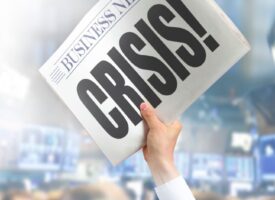They are hiding the truth. This is how bad things are in the United States.
The Truth About The U.S. Is Hard To Believe
November 21 (King World News) – Gerald Celente: The S&P 500 and Nasdaq hit record highs (earlier) this week, with the Dow jumping more than 200 points, continuing its four-week run.
Could they be rising because economies are contracting around the world? The U.S.-China trade war? The unrest in the streets in every hemisphere?
The real answer was found in a survey that polled investors with a combined worth of $574 billion in assets.
Their behavior can be explained, as Michael Hartnett, Chief Investment Strategist at Bank of America said:
“Investors are experiencing Fomo – the fear of missing out – which has prompted a wave of optimism and jump in exposure to equities and cyclicals.”
Simply stated, cheap money encourages further gambling.
Disconnected from the rising inequality, frustrated and struggling citizenry, and collapsing economies around the globe, the survey respondents expect stocks to perform even better next year…
Listen to the greatest Egon von Greyerz audio interview ever
by CLICKING HERE OR ON THE IMAGE BELOW.
TREND FORECAST:
Not only has the U.S. Federal Reserve extended the time period for pumping money into the repo (repurchase agreement) market that provides financial institutions overnight cheap money loans, it is estimated that since 17 September they injected “upwards of $3 trillion,” according to the Interest Rate Observer.
Therefore, as long as the money junkies get their Fed fix to gamble in equites, the overvalued U.S. markets, minus a black swan/wild card event, will maintain and/or moderately rise from their current levels.
Gold, trading in the $1,470 per ounce range, despite what the mainstream business media contend, is not down from its $1,550 per ounce range because of hopeful trade deal resolutions between the U.S. and China.
As we have noted, with the cheap money fix flooding the markets from the Fed that gives the White Shoe Boys more money to play with, no safe haven is needed. Ten-year government bond yields rose this week, although yields are closer to their historic low of 1.37 percent in 2016 than the 3.20 percent reached a year ago.
TREND FORECAST:
Gold is in a critical price range. As long noted, should it drop below $1,450 an ounce, we forecast it will bottom out around $1,390.
Tracking trends is understanding where we are and how we got here to forecast where we are going.
Therefore, Gerald Celente’s forecast over the past five years of gold spiking toward $2,000 per ounce once it broke past $1,450 was based on investors seeking safe-haven assets as bond yields would invert and central banks would lower interest rates, thus cheapening currencies.
On the “how we got here” front, it was unimaginable that the Feds would be injecting trillions into the repo market to keep the addicted Bull running. As long as the cheap money flows continue, equities will stay strong and gold prices moderate.
However, should Middle East and other war-related tensions intensify and/or an unforeseen Lehman Brothers moment arise (i.e., Deutsche Bank/Commerzbank), the overvalued stock markets will dive and gold prices will soar.
TREND FORECAST:
Fed chief Jay Powell indicated interest rates would not be lowered “as long as incoming information about the economy remains broadly consistent with our outlook”… despite pressure from President Trump, who complained last week that the Fed’s put the U.S. at a “competitive disadvantage” by not allowing interest rates to drop into the negative range, such as they have in the eurozone.
Despite Powell’s statement and the word on the Street that the Fed will not aggressively lower rates, we forecast further rate cuts before Election Day 2020, possibly into negative territory, thus again pushing gold prices higher.
And yesterday, the Fed Chair and President met at the White House to allegedly discuss a variety of economic issues.
Following the meeting, President Trump tweeted:
Just finished a very good & cordial meeting at the White House with Jay Powell of the Federal Reserve. Everything was discussed including interest rates, negative interest, low inflation, easing, Dollar strength & its effect on manufacturing, trade with China, E.U. & others, etc.
For those believing the Fed is independent and resists government pressure, as history proves, President Nixon pressured the Fed Chair to lower rates before Election Day and President Reagan gave the Fed Chair orders not to raise rates prior to Election Day.
Cash on the Barrel
Brent Crude is stuck in the low $60 a barrel range. Despite China having the largest amount of oil imports in its history, the global economic contraction and more supply than demand has kept prices soft.
Indeed, U.S. inventories have swelled to about 3 percent above the five-year average for this time of year.
As we noted last week in the Trends Journal, the number of active rigs in the U.S. has declined by 25 percent from the same time a year ago.
The Organization of the Petroleum Exporting Countries (OPEC) is meeting next month to discuss demand and output.
TREND FORECAST:
As goes the global economy (and Middle East wars), so goes oil prices. Indeed, as economies slow down along with demand for oil, Saudi Arabia’s long-promoted initial public offering (IPO) of its state oil group is not attracting foreign investment as expected.
Because of the lukewarm response, on Sunday, the Saudi government sharply cut back its IPO, seeking to raise $25 billion, a fraction of the $100 billion they had previously targeted.
No Retail Boom
U.S. consumer spending rebounded slightly in October, pushed up by a small increase in auto purchases, which ticked up at 0.5 percent following a 0.9 percent decline in September, while gasoline sales, thanks in part due to consumers driving larger gas-guzzling cars, were up by 1.1 percent.
Big retail items, however, took a hit. Electronics and appliance sales fell 0.4 percent. Clothing was down 1 percent and furniture dipped 0.9 percent. Building materials dropped 0.5 percent, and food and drink services were down 0.3 percent.
Household spending in September was 0.3 percent, its first decline in seven months, a downward turn that continued into big retail sales in October.
PUBLISHER’S NOTE:
Wayfair Inc., the top exporter of furniture to the U.S. last year, saw a 14 percent decline in October, despite spending $282 million this quarter on advertising, a 35 basis-point increase year-over-year.
In 2018, China was the top exporter of furniture to the U.S., valuing $34.8 billion. Furniture products are 6.5 percent of China’s total exports to the U.S.
We note this as the talk of trade wars and tariffs are cited by the mainstream media as the key elements for rising and falling equity and commodity prices. What is rarely discussed by them are the broader implications of getting it made overseas to buy it cheaper.
While the last century is ancient history to many, back then America manufactured most of its consumer products, which in turn created living wage jobs and a sizable middle class.
Thus, Americans are hitting stores with cheaper goods. Walmart said its U.S. sales rose 3.2 percent in the third quarter, a five-year streak of quarterly sales gains. Sales from their e-commerce rose 41 percent from one year ago.
TRENDPOST:
The average American is drowning in school loans, auto loans, credit card, mortgage, and medical debt.
In fact, seven of ten Americans are in precarious financial shape, struggling to pay bills or save money, according the Financial Health Network.
And Zillow findings released last Thursday found that four in ten Americans struggle to pay for basic needs such as food and housing and a quarter of renters struggle to pay their rent.
Worry Over Global Markets
READ THIS NEXT! This Worry Is Hanging Over Global Markets CLICK HERE TO READ.
© 2019 by King World News®. All Rights Reserved. This material may not be published, broadcast, rewritten, or redistributed. However, linking directly to the articles is permitted and encouraged








